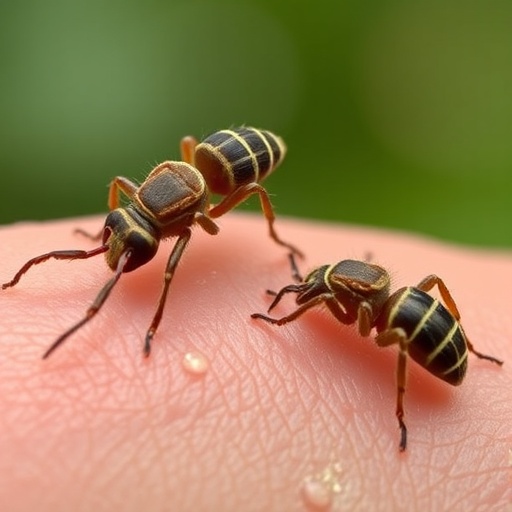
In the intricate ecosystem residing on human skin, a silent and relentless battle unfolds — one that profoundly shapes the microbial communities living in harmony with us. Recent advances in microbiome research have revealed that the interaction of different bacterial strains is far more complex than previously imagined. While it was understood that metabolic competition plays a role in shaping these bacterial populations, groundbreaking new research now identifies intraspecies warfare as a critical factor limiting strain coexistence within the human skin microbiome. This discovery not only deepens our understanding of microbial community dynamics but also holds significant implications for the future of therapeutic interventions and probiotic development.
The human skin is home to a staggering variety of microorganisms, among which Staphylococcus epidermidis stands out as one of the most prevalent bacterial species. These bacteria are more than passive inhabitants—they contribute actively to skin health by preventing colonization by pathogens and helping maintain the skin’s immune balance. Despite their generally symbiotic relationship with the host, S. epidermidis strains do not always peacefully coexist with one another. Instead, fierce battles occur even among members of the same species, profoundly influencing which strains establish themselves and thrive.
To decipher this complex microbial warfare, an international team of researchers employed a multifaceted approach combining detailed genomic analysis with high-throughput agar competition assays. This methodological innovation allowed them to systematically profile nearly 15,000 pairwise interactions between S. epidermidis isolates obtained from 18 individuals across six distinct family units. This massive data set offered an unprecedented glimpse into the competitive landscape of skin bacteria, enabling the team to unravel the intricate web of antagonisms that govern strain interactions.
.adsslot_qOW6PYKrzN{ width:728px !important; height:90px !important; }
@media (max-width:1199px) { .adsslot_qOW6PYKrzN{ width:468px !important; height:60px !important; } }
@media (max-width:767px) { .adsslot_qOW6PYKrzN{ width:320px !important; height:50px !important; } }
ADVERTISEMENT
One of the seminal findings of this research is the revelation that intraspecies antagonisms among S. epidermidis strains are not just common but mechanistically diverse. Unlike the concept of simple competition for nutrients, these antagonisms involved a variety of biochemical weapons and defense strategies, including antimicrobial peptide production, enzymatic assaults, and complex resistance mechanisms. The diversity of these tools suggests an evolutionary arms race occurring on human skin, a battleground where bacterial strains are constantly adapting to outcompete rivals and secure their niche.
Intriguingly, this study found that the antagonistic behaviors between strains were largely independent of their genetic relatedness. Conventional wisdom might suggest that closely related strains would either coexist due to similar lifestyles or aggressively compete due to overlapping niches. Instead, the analysis showed that hostility transcended phylogenetic boundaries, indicating rapid evolution and acquisition of antagonistic traits, possibly mediated by horizontal gene transfer. This evolutionary fluidity further complicates the ecological dynamics on human skin and challenges simplistic models of microbial interactions.
Crucially, the researchers discovered that strains cohabiting the same individual harbored fewer antagonistic interactions compared to those randomly paired from different hosts. This depletion of hostility within a single person’s microbiome points to selection mechanisms that favor tolerance or mutual coexistence in vivo, thus ensuring a stable and functional microbial community. Such a finding underscores the importance of context and microenvironment in shaping microbial behavior and demands consideration of host-specific factors when assessing strain dynamics.
The variability in antimicrobial production and resistance among S. epidermidis strains also sheds light on underlying evolutionary trade-offs. While some strains invest heavily in producing potent antimicrobials, others may prioritize resistance or other fitness traits, such as resource acquisition or immune evasion. These trade-offs determine success in colonization and persistence, as no single strategy guarantees victory in the intense microbial warfare playing out on our skin surface. Understanding these complex cost-benefit dynamics is paramount to grasping how microbial diversity is maintained.
This pioneering work has far-reaching implications, particularly in the burgeoning field of microbiome engineering and probiotic therapies. With the recognition that intraspecies warfare significantly restricts strain coexistence, strategies aimed at introducing beneficial bacteria must account for the antagonistic landscape of the skin microbiome. Simply applying desirable probiotic strains may prove insufficient if resident antagonistic microbes rapidly outcompete or inhibit the newcomers. Therefore, designing effective, lasting skin therapeutics requires an intimate understanding of the mechanisms of microbial conflict and cooperation.
Moreover, the study highlights the rapid pace of microbial evolution on human skin, driven in part by horizontal gene transfer. This genomic fluidity allows strains to acquire new antagonistic capabilities or resistance traits quickly, potentially altering the balance of power within microbial communities over short timescales. Such dynamic change challenges the concept of stable microbiomes and suggests that intervention strategies must be adaptable and informed by ongoing microbial ecology monitoring.
Beyond therapeutic applications, the research enriches our fundamental knowledge of microbial ecology by elucidating the nuanced relationships within a single bacterial species. Intraspecies warfare introduces an additional layer of complexity often overlooked in studies that treat microbial species as homogenous entities. This granular perspective permits greater accuracy in modeling community assembly, resilience, and response to perturbations like antibiotic treatments or skin diseases.
By employing high-throughput agar competition assays, the researchers achieved a volume and depth of analysis unmatched in microbiome studies to date. This approach offers a scalable, robust method for exploring microbial interactions across multiple strains and individuals, setting a methodological benchmark for future studies investigating microbial communities in other human-associated niches or environmental systems. The integration of phenotypic assays with genomic insights represents a powerful paradigm for dissecting complex, multi-dimensional microbial networks.
The identification of distinct biochemical strategies underpinning antagonism also opens avenues for novel antimicrobial discovery. Natural antimicrobial compounds produced by skin bacteria could inspire new classes of drugs or topical treatments, especially crucial amid rising antibiotic resistance. Deciphering the molecular arsenal used in these microbial skirmishes may provide templates or leads for therapeutics targeting pathogens while sparing beneficial skin flora.
Furthermore, insights into the spatial and temporal dynamics of strain coexistence on skin can inform personalized medicine approaches. Since the antagonistic landscape varies between individuals, tailored probiotic or microbial modulation regimens could enhance effectiveness and minimize unintended disruption of resident microbiota. This personalization aligns with wider trends in medicine towards customized interventions based on individual biological and microbial profiles.
The research also prompts reconsideration of how we conceptualize the human microbiome—not as a static community but as a vibrant, competitive ecosystem akin to a battleground with shifting alliances and enduring conflicts. Such a worldview underscores the complexity of influencing these populations and cautions against simplistic or one-size-fits-all solutions. Embracing microbial warfare as a fundamental ecological principle on skin will transform future research directions and therapeutic strategies.
In conclusion, the discovery of widespread, diverse intraspecies warfare among S. epidermidis strains represents a paradigm shift in our understanding of skin microbiome ecology. This competitive interplay restricts strain coexistence in ways far more intricate than metabolic competition alone. The research conducted by Mancuso, Baker, Qu, and colleagues weaves together genomics, ecology, and evolutionary biology to illuminate these hidden microbial battles, offering profound insights with both theoretical and practical consequences. As the skin microbiome continues to reveal its secrets, embracing the complexity of microbial conflict will be crucial to unlocking new horizons in human health and disease management.
Subject of Research: Human skin microbiome; intraspecies antagonism and bacterial strain coexistence
Article Title: Intraspecies warfare restricts strain coexistence in human skin microbiomes
Article References:
Mancuso, C.P., Baker, J.S., Qu, E.B. et al. Intraspecies warfare restricts strain coexistence in human skin microbiomes. Nat Microbiol (2025). https://doi.org/10.1038/s41564-025-02041-4
Image Credits: AI Generated
Tags: bacterial strain coexistence challengescompetition among skin bacteriaimplications for probiotic developmentintraspecies warfare in skin microbiomemicrobial community dynamics on human skinmicrobial interactions on human skinrole of bacteria in skin immunityskin microbiome research advancementsStaphylococcus epidermidis strain competitionstrains of bacteria and their interactionstherapeutic interventions for skin healthunderstanding skin microbiome complexities



